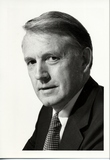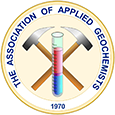ARTHUR G. DARNLEY (1930-2006)

Education provides the passport to life; it is character - created by an indefinable mix of genes, parenting, environment and belief – that charts the course and stages the achievements. Arthur's education was as good as any, but it was his character that led to success. He grew up in wartime and post-war England. I know of no other person, certainly in England at that time, whose university entrance examination included geology. This was not taught at his school, he learned from books and from solo field work. This led to Cambridge University, where he became president of the Sedgwick Club, graduating in geology in 1952. Between school and Cambridge, he served with the Royal Air Force, maintaining aircraft flying the Berlin Airlift. His first job was with Selection Trust as a field geologist in the Northern Rhodesian Copperbelt. There he developed ideas that differed from the conventional views on the origins of these deposits. There was an urge to do more than was possible as a company geologist, so he gathered his rocks and returned to Cambridge for a PhD study. With no economic geology professor at Cambridge, Arthur had to replicate his “teach yourself” experience from school. His 1960 paper on the Copperbelt remains a classic. From Cambridge he moved to London in 1957 to join the British Geological Survey. Lingering economic effects of the war made it difficult to get support; nevertheless he developed an important program on uranium deposits that complemented the contemporary development of nuclear power.
The 1960's were a boom time for geology in Canada and it was to the Geological Survey of Canada that Arthur went in 1966. The timing was good. Management of the GSC were among the elite of Canadian science; moreover they included the last explorers of Canada's north. Although a government organization, bureaucracy had not crossed the threshold. His managers were looking for men with dreams. Arthur's dream was to build a very sensitive airborne gamma ray spectrometer. Uranium, thorium and potassium emit gamma rays that can be distinguished from one another. These elements occur in different proportions in different rocks. So, theoretically, if one were to fly across the country with such an instrument, one could map the different rocks, as well as identifying uranium deposits. Good idea, but there was a problem. Gamma ray intensities decrease with height and enough time must be spent over each location to accumulate sufficient counts. Helicopters can do this by flying close to the ground and slowly, but this was not a practical way of covering large areas. Thus Arthur established a team that built the first highly sensitive spectrometer and installed it in an aircraft. Regional radiometric surveys were born. But there was to be more than surveys of geology. In January, 1978, the nuclear-powered Soviet satellite Cosmos reentered the atmosphere and spread debris across the Barren Lands of northern Canada. A large team from the United States military based in Nevada flew into Edmonton to search for radioactive debris. Their equipment included helicopters with gamma ray spectrometers. These worked well in Nevada, but the helicopters did not have the range for the expanses of the Barren Lands. And their spectrometers were insufficiently sensitive to be carried in aircraft that did have range. The only instrument in the world with sufficient sensitivity was, fortuitously, at the GSC in Ottawa. This was rushed to Edmonton, installed on a Hercules aircraft, and, after several months of work, all the pieces of radioactive debris were located.
In 1971, Arthur added geochemistry to his mandate and became Director of the Resource Geophysics and Geochemistry Division (RGG). With nuclear power becoming more important, uranium resources were scarce, and the price moved higher. This prompted a Federal-Provincial Uranium Reconnaissance Program using both ground geochemistry and airborne radiometric surveys. To maintain a consistent quality of work, national survey protocols were established cooperatively by GSC staff and provincial geoscientists. In 1975 survey work started, carried out by contractors over large blocks of Canada. Maps and data were published before the start of the following field season, to be used by companies for exploration. But federal priorities changed and in 1979, funding of the program ceased. Fortunately, by then the usefulness of the surveys had been recognized, and the work has continued to this day, largely funded by the provinces, but carried out to the same national standards established in 1975.
By the 1980's the character of the GSC was changing and people with dreams were not viewed in the same light as 20 years before. The productivity and focus of Arthur's division had brought increases in staff and budgets. In 1986 a decision was made by GSC management to disassemble RGG and disperse its staff and budget to other divisions. For a lesser man this would have been a signal to exit stage left. Instead, it was the spur to his greatest accomplishment. He turned his attention to the international scene. Regional geochemical surveys, originally carried out for use in mineral exploration, had shown to be even more valuable for providing environmental data. For this purpose, consistent standards for sampling and analysis are even more important. Without this, surveys become as useful as train tracks that change gauge at each political boundary. Arthur moved to extend to countries the same consensus-building that had developed between federal and provincial geoscientists. He established the Global Geochemical Mapping and Global Geochemical Baselines programs, under the aegis of the International Union of Geological Sciences. It is one thing to build a program when one has money to dispense, but for these programs Arthur had none. It was through discussion and persuasion that national organizations agreed to consistent standards. Much has since been accomplished, including published geochemical maps for Europe and for China.
The portrait to this point may give the impression of a life of science. Wrong. Arthur devoted even more care and effort to his family. More than most he led a balanced life. Robert, Ann and Ian, the three children of Arthur and Joan, have grown up to have an equally satisfying and balanced family life. Joan, the children and grandchildren have been the inspiration for his scientific work. Superimposed on work and family, and contributing to both, was his love of flying. Starting in Africa, continuing with his own aircraft in Canada, he flew until a short time before his death. The day after he passed away, the office of the Association of Applied Geochemists sent an announcement to its members. There were replies. One writer described how much Arthur had contributed to geochemistry in his country. The last sentence read: “He was a good man.”
-- Eion Cameron --
September, 2006
